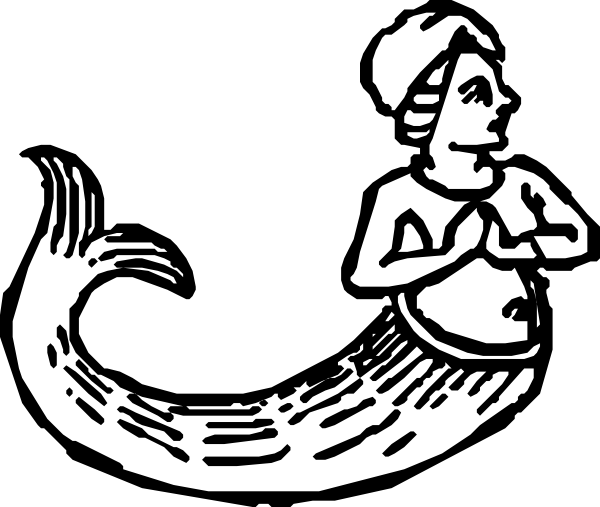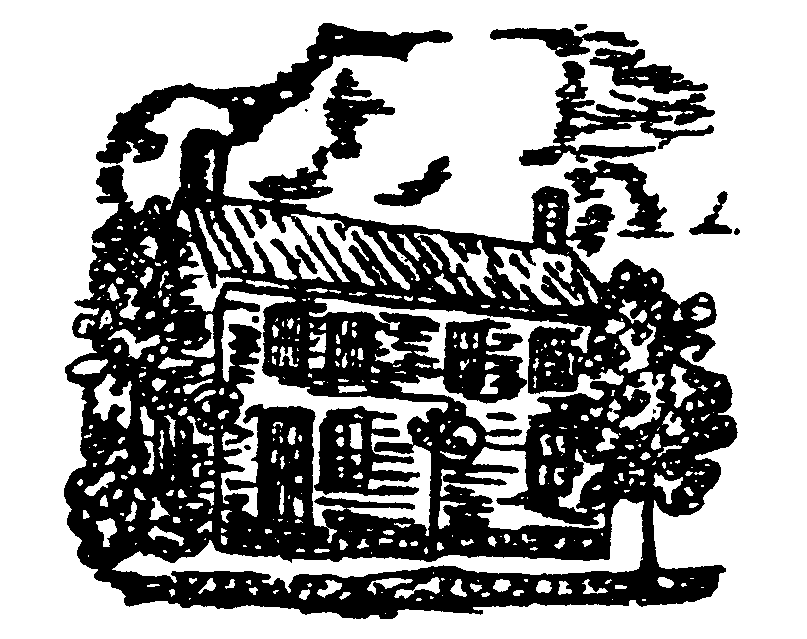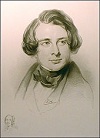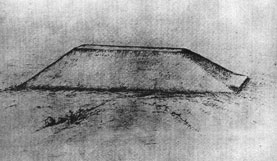Mermaid House
Mermaid House was built in 1830 by retired sea captain Lyman Adams, who said that he believed in Mermaids, had even seen them at sea. (Surely he must have been “all at sea!”)
Mermaid House was the lesser of at least two hotels in Lebanon at the time, the much more lavish Bishop House being located across the alley, facing the public square. But Adams owned the land east of Lebanon from which the Dickens party viewed the Looking Glass Prairie that he had come to see, and it appears that this is the connection that drew his party to the hotel of Adams in town.
Built 1830 by
Captain Lyman Adams


Adams appears to have owned much of the half block on which today’s Mermaid stands, and in all probability other buildings on the site also made up the Mermaid premises. For example, Dickens writes that they were 14 in all, in his stagecoach trip from St. Louis. (See “A Visit by Charles Dickens” later in this document.) That number, plus the proprietor and his family could hardly have been put up for the night in the building that stands today, especially when it is realized that the back two rooms must have been later additions to the building, in view of the exterior style window in the interior wall, plus the outdoor weatherboards on an inside wall, plus the back room divider that is reminiscent of porch construction.
April 12, 1842
A Visit by Charles Dickens

Being one of the most notable writers of his time, Charles Dickens was also well traveled. In 1842 he decided to visit America. After travel from England, he and his entourage made their way to the mighty Mississippi river on which they traveled north, landing eventually in St. Louis. Traveling eastward from St. Louis, they ventured into Illinois with stops along the way, including Belleville and Lebanon on their way to see the Looking Glass Prairie.
Mr. Dickens wrote about this trek in his book, American Notes, where in the later half of Chapter XIII (13) he relays his findings about Lebanon and the Mermaid House Inn. (Read about it here, at the Gutenberg Project’s public edition of American Notes.)
The property passed from Adams about 1845 and into residential use where it remained until 1964, when the building was made available and was purchased by the Lebanon Historical Society, which was founded by Leon H. Church for that purpose.
Restoration, however, was postponed pending what Mr. Church felt was more pressing need for his efforts – saving the Indian mound that stands within sight of Lebanon to the north-northeast, and which was being sold for fill.
By 1973, the mound safely turned over to the State of Illinois, serious restoration of Mermaid House was undertaken, alongside a decade of Miss Mermaid contests that largely financed the work.
The building is constructed of hand hewn oak beams, held in position by wooden pegs. The original plaster was strengthened by horse hair mixed into it, applied over hand cut laths. Restoration has been done so as to preserve visible sections of all the original features, as well as showing some exposed areas that illustrate certain reconstruction that had to be undertaken to restore the building to sound condition.
Mermaid House was a residence from 1845 till 1964.


Preservation of Emerald Mound slowed progress of Mermaid House restorations.
The apparently original fireplaces and chimneys were deemed weak, able to handle gas furnace and gas log replica fireplace fires, nothing more. But almost immediately, the chimneys began to decay; and they have by now been completely replaced with modern masonry, with brickwork restored as closely as possible in case of the fireplaces.
The two back rooms appear to have been added later, probably through the common pattern of adding a porch, then subsequently walling it in.
The front stairwell is of completely modern construction, according to modern building code standards. When the historical society took possession of Mermaid House in 1964, the front stairs rose from lower front to back upstairs; but removal of wall plaster revealed indications that the original position was reverse, and so it has been restored, in the process eliminating the second front door that appeared during the period of private residential occupation.
Floors are largely original, save for portions that had to be removed and replaced to allow installation of new supporting beams in the cellar during reconstruction of the building. Flooring differs from room to room.
Early plans show building was originally wider. Land was subdivided through the house, and the building was cut off and its wall moved in.
Modern conveniences introduced since Dickens’ visit have been retained, including bathroom, kitchenette, electric lighting, furnace and insulation.
Furnishings include Lincoln-style desk and braided rugs donated by Mr. and Mrs. E.G. “Cy” Perkins. Couch was donated by Virginia Chamberlin Pfeffer, who also provided the shawl that hangs in the converted window showcase, a rocking chair found elsewhere in the house, and all the wallpaper in the restored Mermaid House. The corner cupboard came from Mrs. D.M. Church, mother of Leon Church, who also wanted her daybed to come to the Mermaid House, where it now rests in the room above.
America colonial or early republican picture is a gift from Mr. Allan C. “Red” Viguerie, a former Lebanon Historical Society president, whose late wife is memorialized by the hand rail beside the front steps.
A second corner cupboard, of recent manufacturer, hand made by Mr. “Pop” Rawson of East St. Louis.
The dresser is the most likely period piece in the building, as well as having perhaps the closest Dickens connection of any piece in the inn. It was owned by Wm. J. McBride family of Belleville, who also owned the Mansion House hotel there, which Dickens visited and of which he wrote disparagingly following his trip. The dresser came down in the family to a cousin of Leon Church, Mrs. Sherman Stookey, who then gave it to Harrison Church. It is on loan from the Church family.
Other exhibits include other certifications and references to Mermaid House and to Lebanon history. A drawing of Charles Dickens, by local artist Dottie Bennett, is a memorial to the late Prof. Eugene Seubert, whose wife, Alice, donated the framed picture to the Mermaid House, as she did the original charter of the Lebanon chapter of the Dickens Fellowship.
Exhibits in main upstairs room include bean pot from the Bishop House hotel across the alley; a “froh” for splitting wood shingles, and an example of 19th century mechanical ingenuity, the precursor to modern drill presses, used to bore holes for inserting pegs by which buildings were earlier held together. It could be adjusted to allow boring holes at angles. As the crank was turned, not only did the drill bit rotate, but it was also forcibly advanced through the wood.
In upstairs side room is a rope bed on loan from the Leon H. Church family. Unrestored, it nevertheless illustrates how beds were made both warm and comfortable – to a degree – in the times before central heating and metal springs. Atop the criss-crossed rope support rested a bag made of what is called “ticking” material, filled with corn husks, for a basic matress. on top the “tick” was another bag, this one filled with “down” to form a feather-bed both soft and warm.
Take a look at the Mermaid House Hotel/Inn as it stands today. Our virtual tour can be accessed here.
Charles Dickens returned to the United States shortly before his death in 1870 but did not revisit Lebanon. His son did come here just after the turn of the century, and his great-grandson, Mr. Cedric Charles Dickens, came to the inn for a reception in January of 1986, returning to Lebanon later that same year to give a lecture at McKendree College.
Mermaid House has been open by appointment and on special occasions of Lebanon civic events. It is available for meetings by private groups. So far, in recognition of the strong support the inn has received from local people, no admission or use charges have been made, although donations are happily received.